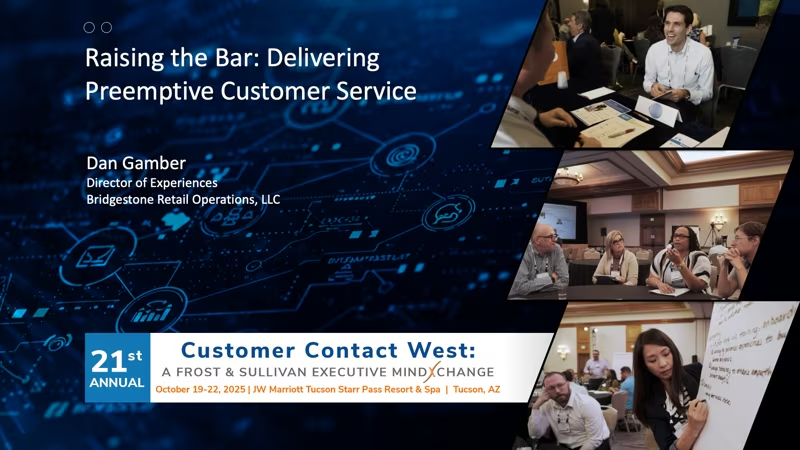By Patricia Jacoby
Senior Editor, Marketing
Frost & Sullivan
On February, 25th Customer Experience experts, executives and leaders looking to learn more about CX convened in New York City to attend a unique new 1-day event: the Customer Experience Ecosystem: A Frost & Sullivan Executive MindXchange. Themed Achieving Organization-Wide Customer Centricity, the inaugural event was designed to combine out-of-the-box thinking with current thought leadership on this timely business topic.
Headliner Melissa Kivett, Senior Vice President, Chief Customer Experience and Marketing Officer, Individual Solutions Group, Prudential Financial, kicked things off with a comprehensive session, Is Your Customer Experience Your Brand? Noting that we are living in an “experience economy,”1 where memory itself effectively becomes the product, she reminded participants that although a good product is still needed, it’s arguably as important to become customer-experience focused, and shared ten key ways to do so:
- Leverage the power of herds: The herd mentality follows what the majority of other people are doing. Who doesn’t go on Trip Advisor to read hotel reviews before traveling? We’re all influenced by our peers, so make sure your company is a crowd pleaser.
- Increase positive engagement: Consistently enhance your product and experience and create multiple benefits to meet rising customer expectations. For example, Morton’s Steakhouse has been known to meet loyal customers with full steak dinners as they depart from a plane, and then Tweet out the delivery to their entire (customer) universe.
- Shift the lens: Shift perspective a bit and broaden the lens you’re viewing customers through…you may see them differently and more fully. Strive for a holistic assessment of their financial and emotional needs and life stage to guide you in offering the right solutions.
- Create a customer-obsessed culture: Think Disney. Definitely expensive, “but customers are willing to pay higher prices because of the experience the brand provides.” And the customer-focused employees make that magic happen.
- Personalize it: This one never gets old. Continue to up your data collection game to create pleasing, hyper-personalized experiences. Understand how AI and machine learning can help enhance engagement, and implement where appropriate.
- Offer shopping flexibility: Mobile purchases and e-commerce continue to grow and Amazon remains the standard bearer for all other companies.
- Think holistically-end to end: Engage the entire organization and encourage employees to build constantly evolving processes and better experiences for customers. Strive to collectively improve on what’s working now, from start to finish.
- Leverage insights: In Japan, some vending machines use facial recognition technology to determine the customer’s gender and age and then recommend products they might like, to deliver the best “experience of convenience” possible.
- Omni channel is more than just one touchpoint: It’s important to seamlessly connect online activity with all other channels (phone, in person transactions) to avoid duplication. The customer experience must be orchestrated intelligently from channel to channel, not delivered in repetitious siloes.
- Empower your teams: As pioneered by companies like Zappos, it’s important to create a culture that allows employees to “walk the talk” and satisfy customers in both traditional and unique ways. Once you do this, be prepared to listen to–and act on–what your employees learn from customers.
Rachna Dayal Goel, Global Director, Strategic Programs, Johnson & Johnson, and Michelle Fromholzer, Senior Director, Customer Focused Innovation, The Janssen Pharmaceutical Companies of Johnson & Johnson, followed the headliners with a session entitled Socializing CX Across the Organization. Together, they discussed the multi-layered and complex challenges involved in communicating and implementing CX across very large organizations. As Rachna noted in her opening, every customer is unique and distinct; even siblings with the same family of origin can have strikingly different preferences and behavioral responses to the same stimulus. Rachna cited the importance of analyzing patient and customer data thoroughly to improve experiences, and shared three key components of their current research on CX:
- Immersion – Spend time in the patient or customer’s environment to develop a thorough understanding of their needs and desires, both met and unmet.
- Innovation –Turn the knowledge gleaned into strategy. After studying “hot spots for innovation” J&J seeks to develop patient-focused solutions and supply chain capabilities.
- Connection –This phase is about delivering the solutions and measuring impact. It includes defining KPIs for projects and ultimately sharing the strategy and best practices with the organization.
Rachna shared that Johnson & Johnson is trying to take more of an agile CX approach, one that consists of rapid trial and error, followed by fixes and relaunches. She admitted that this was a very new approach for her organization and represented a real cultural change in the pharmaceutical industry, too.
Expert Advice
An Ask the Experts! Panel Discussion on Innovating and Disrupting the Customer Experience was another event highlight. The panel was deftly moderated by Michael Truett, Head of Operations – Customer Success and Experience, Newsela, and included participants from State Street, Nathan’s Famous, Lyft, GE Digital and Johnson & Johnson. Some notable customer experience quotes from the cross-industry panel included:
- “Remember, when the going gets tough, your customer will pull you through it, if you solve their problems.” “Our intense industrial B2B space wants a consumer experience, but safety is so important to consider too.” – Amy Aragones, Senior Director, Customer and User Experience, GE Digital
- “Make good, data-driven decisions…but don’t engineer the value out of the product.” “Look for unmet needs to touch the most patients possible.” – Theresa Scheuble, Design Director, Johnson & Johnson
- “I have not seen disruption in our industry like this in 30 years…convenience is now king in the restaurant industry. The first (food) brand that figures out how to deliver an exceptional experience will win.” – James Walker, Senior Vice President, Restaurants, Nathan’s Famous
Gordon Littley, Managing Director, Customer Experience Practice, Verizon Business Group, delivered the Capstone session, What is the Right Balance between Technology and Humanity in Customer Experience? Gordon offered a simple but compelling definition of CX, stating that it is essentially the gap between what the customer expects, relative to what is delivered. He urged the participants to reflect on their use of technology, and to be sure they were using it to make the customer journey better. He encouraged them to avoid the pitfall of applying technology to patch up underlying faulty organizational practices and processes. In closing, Gordon reminded participants that whenever technology is applied, there should always be a human in place to back it up.
1Term first coined by Joseph Pine II and James H. Gilmore in a 1998 paper and subsequent book, The Experience Economy: Work Is Theater & Every Business a Stage



